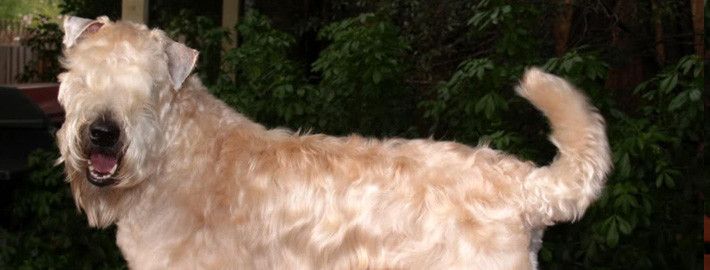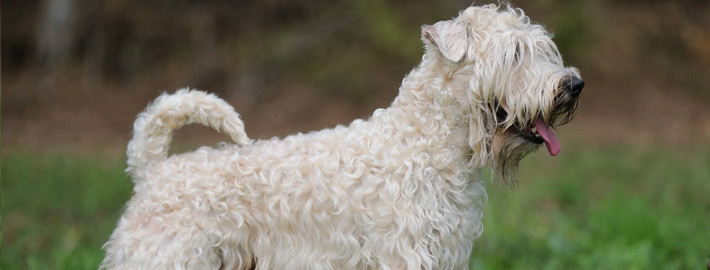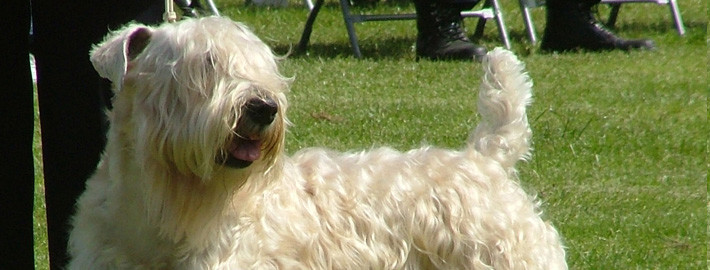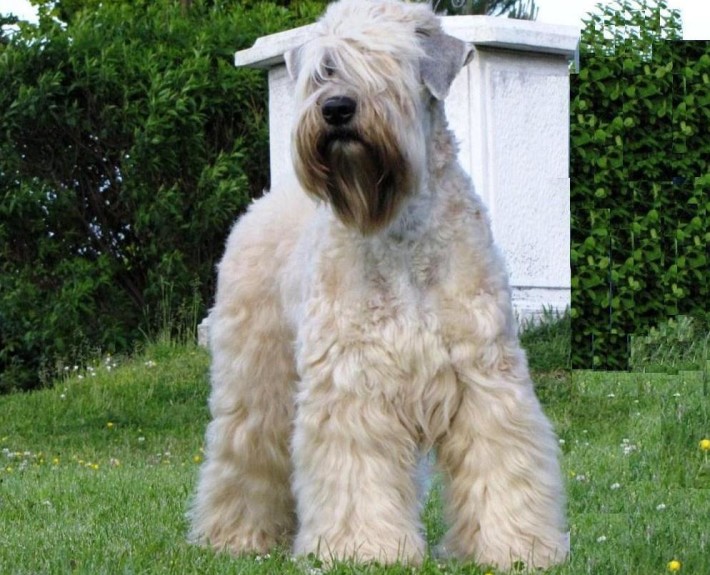What makes the Soft Coated Wheaten Terrier Unique?
The soft-coated Wheaten terrier is an all-around dog, square-proportioned, graceful and strong, not exaggerated in any way. It is large enough to function as a general farm worker yet agile enough to perform its job as vermin exterminator. Its gait is free and lively with good reach and drive; the tail held erect. Its abundant, soft, single coat distinguishes it from all other terriers. It is long and silky with a gentle wave. The overall appearance is one of grace and strength in an alert and happy dog. The Wheaten makes a playful companion at home and a fun-loving partner in the field. It is affectionate, congenial and much gentler than most terriers. It is generally responsive to its owner’s wishes but can be headstrong at times. It is good with children (although some may be overly boisterous with small children) and usually good with other household dogs and pets. It may dig or jump.
Page Contents
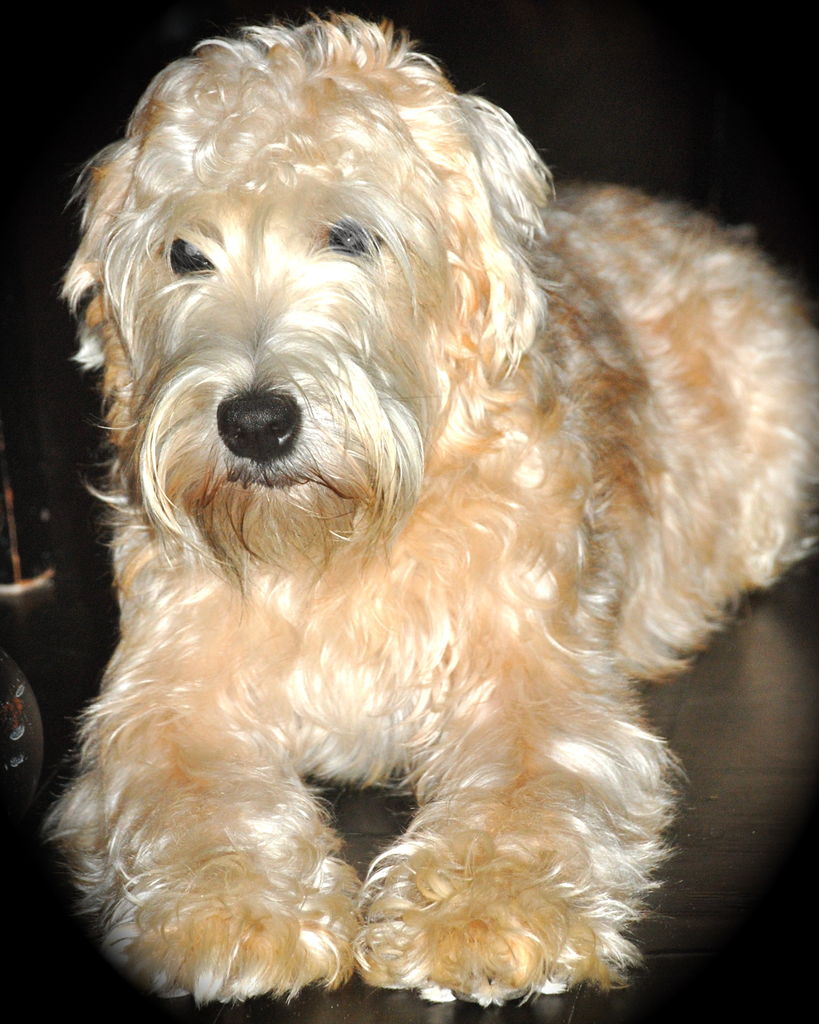
Is the Soft Coated Wheaten Terrier Right For You?
Right Breed for You? If you are considering purchasing a Soft Coated Wheaten Terrier puppy, learn more. *Terrier Group; AKC recognized in 1973.
Wheatens tend to be less scrappy than other terriers but they are true terriers and will be more active than many other breeds, enjoying plenty of exercise every day. They relate well to children and can adapt to city, country, and suburban life. The Wheaten is single coated and sheds minimally, but needs regular grooming to keep its coat mat free.
*Ranging in size from 17 to 19 inches tall at the shoulder and weighing between 30 and 40 pounds.
*Small game hunter; farm dog.
In 5 Words
- Playful
- Faithful
- Intelligent
- Spirited
- Energetic
Characteristics
Learn About the Soft Coated Wheaten Terrier
Description
The Soft Coated Wheaten Terrier is a compact, medium sized dog of square proportions. The coat comes in various shades of wheaten and has a wavy texture. The head is rectangular, long, with a defined stop and a strong muzzle. The V Shaped ears fold forward, level with the skull. The teeth should ideally meet in a scissors or level bite. The eyes are almond-shaped, brown and have a very lively, very terrier-like expression. The large nose should be black. The back is strong and the topline level. The Wheaten tail is customarily docked, and is carried upright at all times.
Size and Weight
Mature males should stand 18 to 19 inches at the shoulder, with the ideal height being 18.5 inches. Females should stand 17 to 18 inches at the shoulder, with the ideal being 17.5. Males should weigh 35-40 pounds, females should weigh 30-35 pounds.
Coat and Color
The Soft Coated Wheaten Terrier sports a single coat of silky hair that covers the body in waves and falls over the eyes. They come in any shade of wheaten ranging form light beige to gold. There may be some white, red, or black hairs interspersed in the coat, and the muzzle and ears may sometimes be blue-gray. Puppies are born dark and lighten as they mature. It can take up to two years for the dog’s final color to appear and for the hair to achieve its wavy texture.
Short History of the Soft Coated Wheaten
The Soft Coated Wheaten Terrier is one of three big Irish terriers. Bred as a versatile farm dog, it excelled at its tasks — whether it be guarding the house (or barn) or exterminating pesky vermin — for more than 200 years in Ireland. The Wheaten Terrier would later become an effective gundog, locating and retrieving game for hunters.
The origin on the Wheaten Terrier’s history has not been well documented, but it is said that the Kerry Blue Terrier is a direct descendant. Legend has it that when the Spanish Armada was sunk off the shores of Ireland, the blue dogs that swam ashore were welcomed by the terriers with a soft wheaten coat.
Its presence as a show dog was not immediate. In fact, it was not until March 17, 1937 (a most fitting day for any Irishman) in Ireland that the Soft Coated Wheaten Terrier was granted breed status and allowed to enter the Irish Kennel Club Championship Show.
In 1943, the English Kennel Club granted recognition to the breed, and in 1946, the Wheaten was introduced to the United States. U.S. dog fanciers were no more keen to the breed than their British counterparts initially. But once the Soft Coated Wheaten Terrier Club of America was established on St. Patrick’s Day in 1962, it gained much popularity. The Americal Kennel Club would later admit the breed into registration in 1973.
Today, the Soft Coated Wheaten Terrier is loved by both those seeking agile dogs for agility trials or a fun-loving, affectionate companion for the home.
Temperament
The Soft Coated Wheaten Terrier is strong, agile and well-coordinated. It is a happy, playful, spirited and friendly terrier. Alert, it makes a great watchdog and barks at the arrival of guests. It is usually very loving with children and gets along reasonably well with other dogs. An unsocialized dog with a meek owner who does not know how and when to correct negative behaviors may end up with a dog-aggressive dog. Some of these dogs that were not raised with cats may not get along well with them. All it takes is some fast movement on the part of the cat, and the dog’s instincts will take over and he will chase them. The dog needs to be corrected right before it takes off after the cat. These dogs have a puppy attitude that remains with them throughout their lives. They are sweet-tempered, docile and self-confident. This breed needs to be taught, preferably when young, but older dogs can learn what is and is not acceptable behavior. It is very intelligent, so it will generally grasp quickly what is required of it. It has a straightforward nature and needs to be handled in a straightforward manner. Soft Coated Wheaten Terriers bond closely with their family. They seldom bark unnecessarily. The Soft Coated Wheaten should be well socialized with other dogs while it is a young puppy, but adults can learn what is unacceptable behavior if they have an owner who properly communicates with them. In order to have a well-behaved Wheaten, you must be firm, but calm, consistent and confident with the dog. Meek owners will find the dog will easily take over the home and will be hard to control. Do not allow this dog to jump on humans. Jumping dogs are not “greeting” the human. Jumping is a respect and a dominancy issue.
Caring for Your Soft Coated Wheaten Terrier
General Health
The Soft Coated Wheaten Terrier, which has a lifespan of 12 to 14 years, suffers from progressive retinal atrophy and canine hip dysplasia. It is prone to some minor health problems such as renal dysplasia and Addison’s disease, and major problems like diseases causing protein loss. To identify some of these issues, a veterinarian may run hip and eye exams and urine protein screens on the dog.
Grooming & Bathing
Wheatens so not have an undercoat, so they shed very lightly throughout the year. Daily grooming is required to maintain the proper look and feel of the coat, but dogs who aren’t being shown can get away with a scruffier appearance and three days of grooming per week. Baths are only required as needed.
Check the ears on a weekly basis for signs of infection, irritation, or wax build up. Cleanse regularly with a veterinarian-approved cleanser and cotton ball. Brush the teeth at least once per week to prevent tartar buildup and fight gum disease. Additionally, nails should be trimmed once per month if the dog does not wear down the toenails naturally.
Exercise & Training
The Soft Coated Wheaten Terrier can get by with moderate exercise as long as it is taken for daily walks.
The Soft Coated Wheaten Terrier should be trained at an early age using positive training methods that enhance the bonding between the trainer and the dog. They should never be trained using punishment methods as this can seriously limit the dog’s trust of his or her owners. The breed does tend to want to play and clown around, so trainers should plan to provide a playtime before and after each short training session to encourage this wonderful dog to engage in the training activities. Repetitive training is not required and will, in fact, cause the dog to be less compliant.

